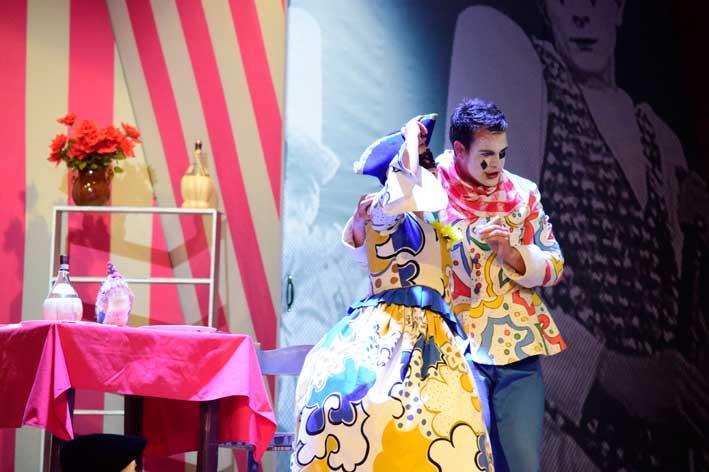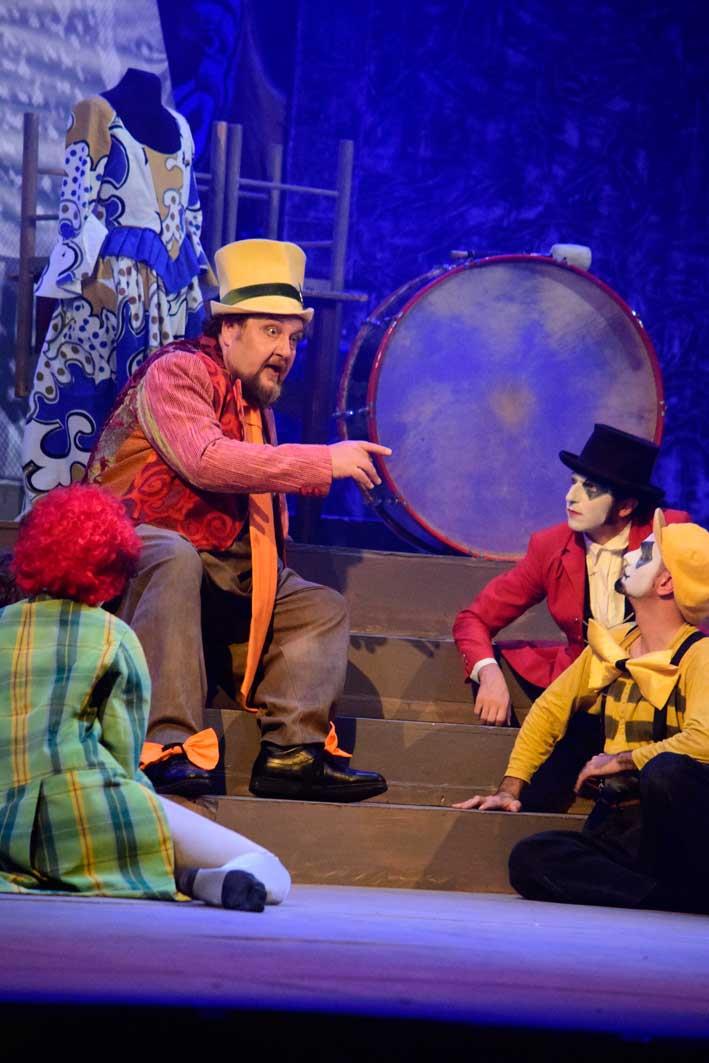Forty years is a long time in the history of opera in Malta and it is no mean achievement for the Leone Philharmonic Society to have presented annual opera productions all this time in its purpose-built Aurora Opera House in the main road of Gozo's capital city. At first put on largely by volunteers with perhaps one or two good, or even not-so-good, foreign singers in the main parts these productions have also seen a number of the great international singers on the stage. Then, however, the less important roles as well as the artistic direction left much to be desired. While the big input from volunteers has survived these performances have grown into productions that can hold their own beside most productions in many opera houses world-wide.
For its 40th anniversary the Leone Philharmonic Society presented a double bill of two verismo operas in the Italian repertoire: Mascagni's Cavalleria Rusticana and Leoncavallo's Pagliacci.

Cavalleria Rusticana burst upon the operatic world in 1890 like a bombshell, its impact being felt around the world in record time. It was derived from a naturalistic short story by Verga, a drama of infidelity and revenge, that for the first time in the history of Italian opera put on the stage not the aristocratic world of courtiers and princes but the raw feelings of Sicilian peasants. Santuzza was not seduced by a lord but by one of her ilk. While introducing new touches such as the insertion of a tenor serenade into the prelude, Mascagni retained much that was conventional in the succession of choruses, arias, duets etc..
Among the many imitations that were triggered by Cavalleria, the only work to demonstrate anything approaching its staying power was Leoncavallo's Pagliacci, written only two years later, that deliberately set out to match the effectiveness of its model. Like it, it is a drama of love, jealousy and revenge among ordinary village people. The contrast between the celebration of Easter and the sordid tragedy of the latter finds a counterpart in the opposition bewtween the artificiality of the commedia dell'arte playlet and the 'real-life' emotional conflicts of the actors taking part in it. Leoncavallo's prelude is interrupted not by a serenade but by a Prologue, one of the finest arias in the opera. Since 1983 the two operas, both because of their style and of their length, have been consistently performed as a double bill.

Like any self-respecting opera both Cavalleria and Pagliacci have as their main characters tenor, baritone and soprano. Cavalleria also has a mezzo that is absent in Pagliacci. It is not very common for a tenor to sing the main parts (Turiddu and Canio) in both operas on the same night. Yet this is exactly what tenor Giancarlo Monsalve did. Monsalve has a fine big voice, a very handsome presence and is a fine actor. Vocally he fared better in Pagliacci than in Cavalleria where his delivery suffered from occasional inconsistency. Having said this, however, his leave-taking scene from his mother, Mama Lucia (beautifully sung and performed by Graziella Debattista), before the final denouement was extremely touching - his fear, his reluctance to leave, taking over from his bravado.
Alberto Mastromarino too sang the baritone part in both operas and like Monsalve's his Tonio in Pagliacci was superior to his Alfio in Cavalleria, where he was occasionally out of synch with the orchestra. His famous character piece Il cavallo scalpita lacked incisiveness and was overshadowed by the gambols of the vilage children. On the other hand his singing of the Prologue displayed all the resources of his fine warm voice and technique. Histrionically too he found a good balance between reality and illusion. Between them, he and Monsalve brought out all the tragic qualities of the piece that becomes increasingly more intense as the action develops.
Joanna Parisi was vocally an excellent Santuzza (Cavalleria). Her clear expressive voice was full of emotion and made up for the fact that she was too reliant on the conductor for her cues. In fact she threw away the two climaxes that mark her drama: falling down the steps of the church when pushed by Turiddu, which was clumsy, and throwing down a big cross that she had hanging round her neck that was spoilt by a fortuitous dropping of the same. Soprano Elena Klessidi as Nedda in Pagliacci was no comparison to Parisi. Her voice was weak (she was the only one of the singers to be overpowered by the orchestra in her Minuet in the play within the play) and often struggled to get her cues. Her love duet with Tonio lacked passion.

In both operas the chorus plays an important part both as commentator and to push forward the action. The Aurora Opera Chorus was vocally in excellent form both when singing on stage and off stage. If it tended to be too rigid in its movements, this was the fault of the artistic director rather than a musical shortcoming. Tenor Cliff Zammit Stevens in the small but attractive part of Peppe and baritone Mario Giossi as Silvio in Pagliacci both did well. The same cannot be said of Christine Dalli in the part of Lola in Cavalleria. Her voice was weak and she was badly directed.
In different ways the two operas are musically very rich. Both, but particularly Cavalleria, have a generous outpouring of melodies typical of the melodic genius of the composers of the Italian school, and both operas contrast the bustle and gaiety of the crowds wih the passions of the main characters, more so in Pagliacci. All the tragic elements of the story of Cavalleria are concentrated in a musical framework meant to convey maximum immediacy. Mascagni attained his aim of creating an opera realistically dominated by sentiment by using formal means, making use of closed numbers and their interaction with recitative. Through a series of continuous scenes he creates a fluid background to the individual passions. Although the overall feeling is dark there are lighter moments, such as the powerful prayer towards the beginning, Lola's stornello "Fior di giaggiolo", the chorus when the congregation comes out of the church and Turiddu's drinking song. Yet the serenity of village life is contrasted musically with the passions devouring the main characters.
Leoncavallo's more sophisticated score, on the other hand, treated each scene as a unity in which the numbers are cleverly used sometimes as traditional structures, such as the Bell Chorus and Nedda's ballade in the second scene, sometimes incorporating melodic references and leitmotifs, and sometimes combining both possibilities. The writing for the voices is more complex with a greater concern for expressiveness, including octave jumps and chromaticism, that makes difficult demands on the singers. Pagliacci contains the only really lyrical excerpt in the two operas - the rather long love duet between Nedda and Tonio which the musical director chose to perform in toto.
Colin Attard was in command throughout leading the Malta Philharmonic Orchestra in a first-class performance in which solo instruments such as the harp, as well as the brass section, were in particularly good form.
Gianmaria Romagnoli's direction of the two operas worked better in Pagliacci. Protagonists, chorus and extras were directed to bring out the the contrast between reality and fiction: the naturalness of village life, and the artificiality of the actors' life which however becomes reality. The opening scene was full of life and gaiety. The circus acts were well integrated and the spaces on the stage were used to maximum effect. The direction of this opera, like that of Cavalleria, was free of unnecessary gimmicks which so often go against the spirit of the work.
The superb libretto of Cavalleria was allowed at all times to come out clear with its accompanying musical phrases. However the chorus looked grim throughout, and apart from the scene with Alfio, and thus failed to bring out the lighter touches that punctuate and create important contrasts. The procession, headed by a statue of Our Lady of Sorrows, looked grim and lacked the joy of Easter as did the peasants returning to their spouses after Mass. It was difficult to see the point of having so many of the members of the chorus and extras wear white masks. Having Lola wear formal red dress, as opposed to the overall black of the rest of the cast, and letting her occupy centre stage for most of the scene in which she appears was a mistake. It is true that she triggered off the tragedy but in point of fact hers is a very minor role. In his programme note the director said that he sees Santuzza as a sort of present day Medea, but the staging of the ending with the dead Turiddu being brought on-stage and laid at the feet of his mother in a sort of tableau depicting the Pietà highlighted Mamma Lucia's tragedy rather than Santuzza's. Was this the reason why the procession was headed by a statue of the Virgin rather than the risen Christ? The production came to life mostly because of the acting of Turiddu, Alfio and Mamma Lucia.
As usual the production was accompanied by a very fine programme with excellent contributions by Albert Storace, Emy Scicluna and especially Abram Borg apart from the libretto - a valuable addition to the collection of Aurora programmes.
Photos: Manuel Xuereb